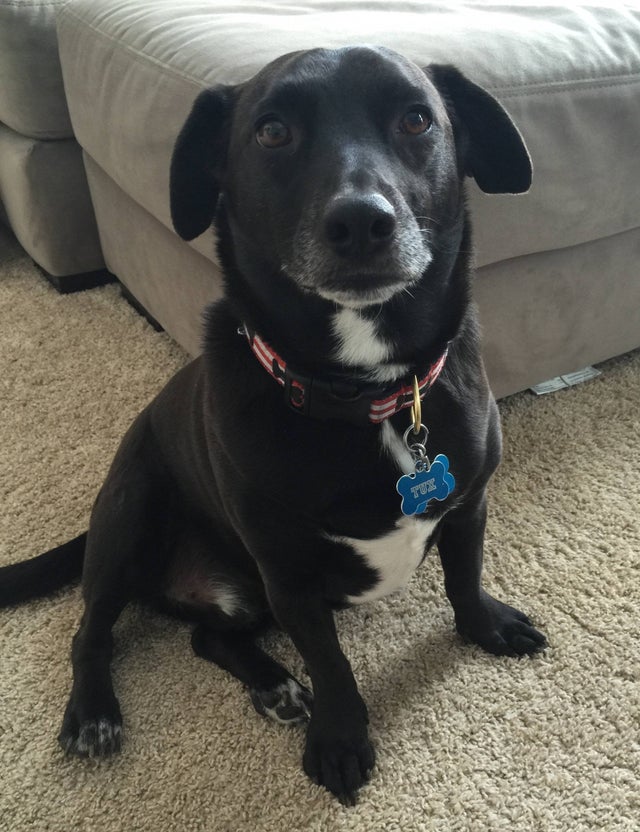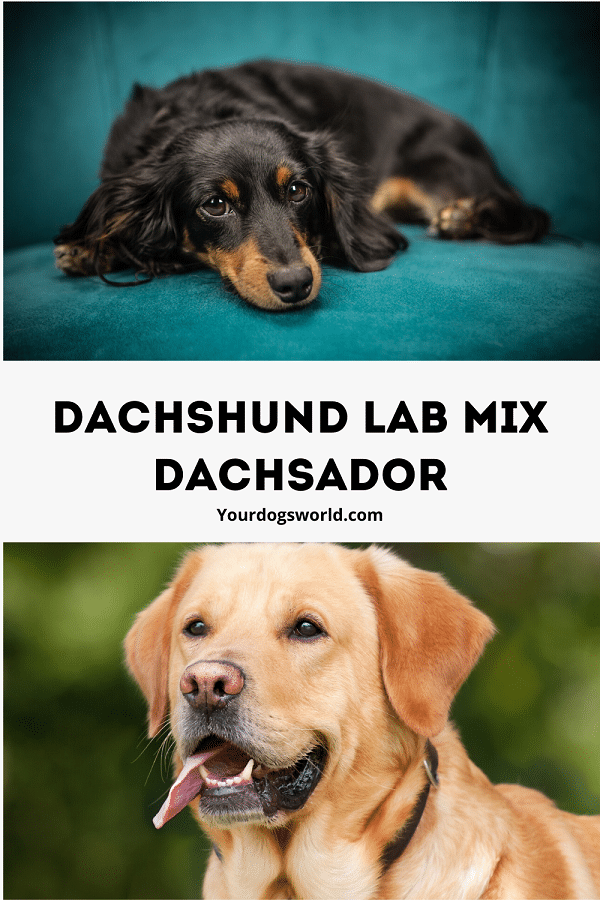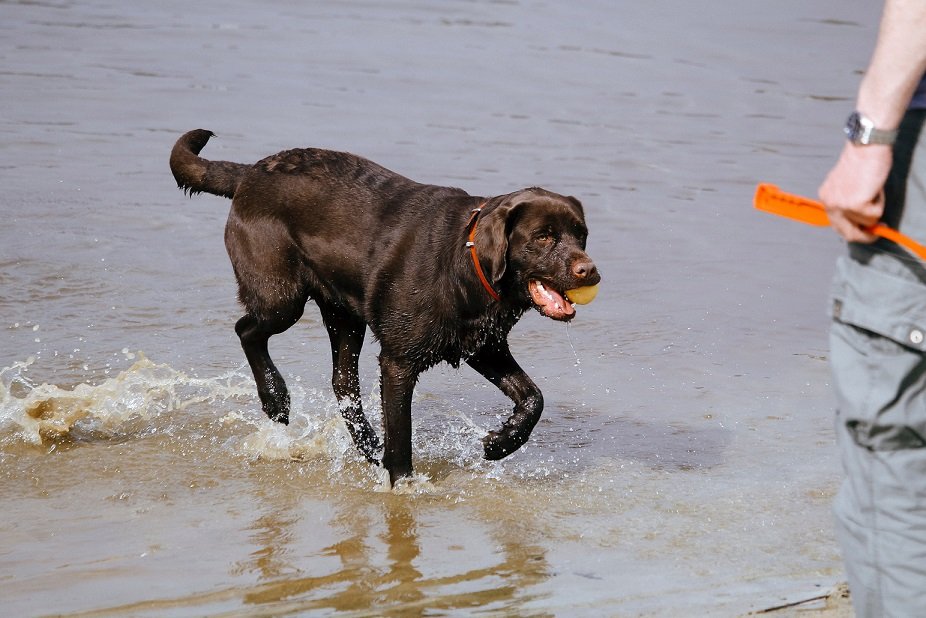Let us give you all details that you want to know about Dachsador – A dachshund lab mix.
So what is a Dachshund lab mix? Dachshund lab mix is a crossbreed of two very different dogs i.e. Dachshund and Labrador Retriever. They are also known as Dachsador, doxidor, or weinerdor.
Dachshund is a short dog with a long body with traits of hunting as they were originally bred as scent hound dogs for hunting badgers.
Whereas, Labrador is a friendly, medium to large, and relatively taller dog bred as a companion or water retriever.
Dachshund lab mix at a glance?
| Size | 15 – 25 inches |
| Weight | 30 – 40 lbs |
| Temperament | Friendly, social and energetic |
| Lifespan | 12 – 14 years |
| Price | $500 to $1,000 |
| Purpose | Companion dog |
| Popularity | Low |
| Grooming | Low |
| Hypoallergenic | No |
How do you get a Dachshund lab mix?
With so much size difference, you might wonder as to how one gets a Dachshund lab mix. Well, it is very rare for a Dachshund father to impregnate a Labrador mother. Most commonly breeders artificially inseminate a Labrador mom.
For a dachsador, the labrador is always the mommy as a dachshund mother would die giving birth to large puppies.
Appearance of Dachshund lab mix
The appearance of the dachshund lab mix is unpredictable and will vary litter to litter. This would be dependent on which parent has the dominant genes.
Let us give you some details on what is more likely that you can expect.
Body: Dachshunds are prone to spinal injuries due to their very long body. This is set right when you mix a dachshund with a labrador.
Dachsador gets relatively better-balanced legs compared to their body. They typically have a compact muscular body similar to a lab.
Face: Muzzle of Dachshund lab mix is pointed and they mostly have floppy ears.
Eyes: It is likely Dachshund lab mix would have dark brown eyes.
Coat: They generally get the coat characteristics from Dachshund. The coat is dense, short, wiry, and water repellent. Dachshund lab mix comes in varied colors like chocolate brown, yellow, and black.
Tail: They are expected to have a curly tail.
Size: Dachshund lab mix can grow to a height of 15 to 25 inches and weigh approximately 30 to 40 pounds. The average lifespan of dachsador is around 12 to 14 years.

Dachsador – temperament
Here are a few personality traits that you can expect when looking for a Dachshund lab mix.
Cheerful and Energetic
Dachshund lab mixes are high energy dogs who would love to play along with you and can be a great companion dog for an active family.
Family friendly
They are quite loving and affectionate dogs who would love to cuddle with you. They thrive on the human relationship but that means they are also prone to separation anxiety.
Loyal
Dachshund lab mixes are loyal and obedient dogs who would stand with you.
Intelligent but obstinate
Dachsador gets their intelligence from Labrador but can be obstinate as well, a trait they inherit from a dachshund. This can make them a bit difficult to train.
Noisy? Not really
They do not bark much unless required and hence are good dogs if you would like to keep things quite.
High Prey drive
They get their prey drive from Dachshund and can chase small animals like squirrels or rabbits.
Stranger is no danger
They are human friendly and that may include strangers as well. Thus they are not good guard dogs.
Good with children
They are children friendly dogs who would love to play along with children but we would advise adult supervision.
Apartment friendly
They are considered apartment-friendly as long as they can get their high energy needs satisfied with long walks or playtime.
Dachshund lab mix – Care
Nutrition
It is recommended that they have 2 to 3 cups of high-quality dry food a day, divided into two meals. With both of their parents being greedy eater, be careful of the amount of diet you are giving to him.
If he is not active or doing enough exercise and eating more food, he is prone to become obese. Diet should be based on the size and activity level of the dog. You can also consult a Vet in case of any issues.
Meat should be the number one ingredient in their food. Protein sourced from meat is required for healthy muscles. It should be at least 18 % of the total diet.
We recommend Nutro Wholesome Essentials Natural Adult Dry Dog Food for Small & Toy Breeds.
Exercise
Dachsadors are highly energetic dogs who would love to play along with you. They can adjust to apartment living as well but it is recommended that they have a couple of long walks every day.
Grooming
Dachsador would generally have short hairs and shed moderately. They are not hypoallergenic dogs.
They typically require low grooming. 10 – 15 minutes of brushing twice in a week should be good enough to keep their coat clean and magnificent.
We would recommend HandsOn Pet Grooming Gloves that can just do the job for him.
Though rarely long-haired dachshund is crossed with a labrador and you may find a long-haired dachsador dog. In this case, the grooming requirement would increase.
Training
There are some important aspects for which dachsador has to be trained. They inherit these from Dachshund.
Potty training – One thing that a dachshund owner would know is the difficulty to potty train him. This can be inherited by the Dachshund lab mix as well.
High prey drive – Dachshund was originally bred as scent hounds for hunting badgers, rabbits, etc. Dachsadors dogs can also have high recall and chase & hurt small animals.
Digging – They love to dig and positive reinforcement training is required to stop them from doing it.
Separation anxiety – They love to be in human company. If left alone for long, they are prone to suffer separation anxiety. It is recommended to do the crate training for them since puppy age.
Though labrador dogs are intelligent and easy to train, dachshund can be obstinate at times. This makes dachsador a bit difficult to train.
We would recommend starting the training for them since puppy age along with socializing them with other people children and pets.
Health
With this being a new designer crossbreed, not much has been learned about them to be certain of any health issues that they may be specifically prone to.
They may inherit some of the genetic health issues of dachshund or labrador. Below are a few which you should be aware of.
Hip dysplasia
It is a medical condition in which thigh bone doesn’t fit snugly into the hip joint leading to arthritis as the dog ages.
This is an inheritable disease and dogs having this should not be bred. A way to control this would be to keep the dog’s weight in check.
Elbow dysplasia
Elbow dysplasia means abnormal development of the elbow joint. This causes damage to the cartilage surface of the joint and again leads to arthritis.
This is also an inheritable disease and dogs having this should be neutered.
Back problem
They inherit this condition from Dachshunds. Having a long body, these dogs are prone to back problems. It can happen if they fall or jump on or off the furniture.
Epilepsy
Dachshunds are prone to having epileptic seizures which can be inherited by dachsador dogs. Most often it can be controlled by medication.
Progressive retinal atrophy (PRA)
This is a medical condition that impacts the retina. Symptoms start from night blindness which slowly leads to permanent blindness in one to two years.

Pros and Cons of a Dachshund lab mix
| Pros | Cons |
|---|---|
| Low grooming requirements | Health Issues |
| Friendly and Loyal | Not good as guard dogs |
| Energetic and Cheerful | Prone to separation anxiety |
How to get a Dachshund lab mix puppy?
Dachshund lab mix is a new designer crossbreed that would not be easy to find from a reputable breeder. Instead, you can first check at the rescue center of Dachshund and then labrador.
But before you take one at home in excitement, do spend some time with him to know each other. And once you are sure, you would be all set.
Adoption would give a new life to a dog and would be great for you as well. The adoption fee for this dog ranges from approximately $200 to $400.
In case you would like to go for a breeder, we would suggest you do some basic checks to avoid any difficulties later. Few tips that you can follow are –
- Reference checks of the breeder from past owners and locals.
- Check all the health records of puppy and parents as this dog is prone to a few genetic ailments.
- Look at the area where puppies and dogs are kept for lighting and cleanliness at the breeder’s place.
Origins
Designer crossbreeds are relatively new and Dachshund lab mix is believed to be originated in the last couple of decades but there are no records to be certain.
We can take a look at each of the parent to understand the traits which they can follow based on the dominant genes.
Dachshund

The dachshund was originally bred in Germany 600 years ago as scent hound dogs to hunt badgers, rabbits, etc. They are quite popular dogs in the USA. AKC ranks them at 12th in their list of 195 popular dogs.
They are iconic dogs who have featured in popular movies like Toy Story, Secret life of Pets, Hugo, etc.
Dachshunds are known for their characteristic low silhouette and long round body. They come with a big personality and a loud bark. They are confident dogs with an alert expression.
These dogs have a long muzzle. The nose is typically black or dark brown. Their dark eyes are medium size and almond-shaped.
Dachshunds are playful and loyal dogs who love to bark. They can be obstinate and are difficult to train.
It is recommended to do potty training, crate training, and obedience training for them since the beginning.
They come in 3 different coats. The short smooth coat is the most popular in the USA. The other hair types are short wiry coat and long-haired.
They come in two different sizes – standard and miniature.
Standard Dachshund can grow to a height of 8 – 9 inches tall and weigh approximately 16 to 32 pounds.
Miniature Dachshund can grow to a height of 5 – 6 inches tall and weigh less than 11 pounds.
The average life span of Dachshund is 12 to 15 years.
Labrador

Labrador are the most popular dogs in USA. They rank number one in AKC popular dog list.
They were originally bred in the Newfoundland region of Canada since the 1700’s to help local fishermen as water retrievers.
Labs have a muscular and athletic body and are part of the sporting group of dog breeds. They need at least 30 to 60 minutes of exercise every day.
Labs are intelligent, sweet-natured dogs with a friendly demeanor and plenty of energy. They thrive on human relationships to an extent they love strangers as well and don’t do well as guard dogs.
They are great companion dogs who bond well with all members of the family, neighbors, and other pets as well. 🙂
Labs weigh approx 55 to 80 pounds and are generally 21 to 24 inches tall at the shoulder. The average lifespan of the labrador dog is around 10 to 12 years.
Final Thoughts
It might look surprising to one that lab and dachshund can also breed. We believe that humans shouldn’t cross the natural boundaries and hence don’t recommend breeding two breeds with so much difference in size.
At the same time, it doesn’t mean that we don’t respect the views on the other side. In fact, there is a study done that says that breeding between two different dog breeds may help in making healthy offspring. It is known as hybrid vigor.
Dachsador can be a good family pet if you have time to play or enjoy his company. You also understand and would be able to satisfy his exercise needs.
Also, it is important to invest in the training and socialization for him since puppy age. This will make him a well-rounded dog. We would just absolutely love a HAPPY DOG which means a Happy you!
Do you know or own a Dachshund lab mix? Leave a comment and share your story below!

